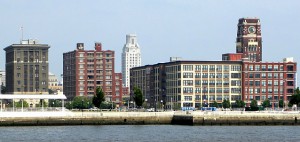New Jersey Future Blog
Economic Opportunity Act Retains Incentives’ Focus on Smart-Growth Locations
December 5th, 2014 by Tim Evans
The New Jersey Economic Opportunity Act (EOA) was signed into law in September of 2013, consolidating five state economic development tax credit programs into two – the Grow New Jersey Assistance Program (Grow NJ) and the Economic Redevelopment and Growth Program (ERG). In the run-up to the EOA’s passage, New Jersey Future successfully advocated for these programs to include bonuses or priority treatment for applicants located in, or seeking to locate in, any of the following types of “smart-growth” locations:
- “designated growth areas” established by adopted state and regional land-use plans:
- “metropolitan” or “suburban” localities per the State Development and Redevelopment Plan (Planning Areas 1 and 2, in State Plan terminology)
- designated centers in other Planning Areas
- areas designated for growth by one of the state’s three regional land-use plans:
- transit-oriented development (TOD) locations, defined as being within half a mile of a transit station (rail, ferry, or major bus terminal) – these locations had earlier been the exclusive focus of the Urban Transit Hub Tax Credit, which was subsumed into the ERG program by the EOA
- municipalities with weak real estate markets, typically described as economically “distressed”
During the year since the act’s passage, its merits have been much debated. It has been criticized for being too generous and too expensive, and praised for its ability to attract and retain jobs and to stimulate real estate development. But lost in the discussion has been consideration of its impact on the geographic distribution of employment – whether it is encouraging employers to locate in places where infrastructure, including public transportation, that can accommodate growth is already in place, or if it simply perpetuates the state’s recent default development pattern of consuming open space and farmland at the suburban fringe. Employer locational decisions are an important driver of overall development patterns, since residential growth tends to follow employment growth as people seek to minimize the hardship of their commutes.
To evaluate the effectiveness of the EOA’s smart-growth provisions, New Jersey Future has produced a report, New Jersey’s Economic Opportunity Act and Smart Growth: A Progress Report, that examines the locations of projects receiving economic-development awards, both before and after the act’s passage. The post-EOA study period comprises only the nine months thru June 2014; therefore, findings should be considered preliminary, since patterns appearing in the initial round of awards may not persist as the sample size increases.
The good news is that the Grow NJ and ERG programs appear to be functioning reasonably well at steering economic growth into smart-growth locations; all but one of the 122 projects we examined were located in one of the types of locations enumerated above. This also illustrates the effectiveness of the State Development and Redevelopment Plan in guiding state investments in growth and development.
The Grow NJ and ERG programs also continue to direct almost two-thirds of their awards (both in terms of number of projects and dollar amounts) to the state’s most fiscally and socioeconomically distressed cities, towns, and inner-ring suburbs, as their predecessor programs did before the EOA’s passage. Camden in particular has benefitted from the EOA’s targeting of four of the most distressed of the distressed places – the other three being Trenton, Paterson, and Passaic – by designating them as Garden State Growth Zones (GSGZs), reducing the project size eligibility requirement and increasing the size of the awards for projects in these municipalities. Camden accounted for four of the five post-EOA awards that have been given in the GSGZ municipalities, after having received only a single award in the entire pre-EOA period.
However, one casualty of the consolidation of the state’s economic development programs appears to be the focus on transit. The dissolution of the Urban Transit Hub Tax Credit (UTHTC) program, which issued awards exclusively in transit-accessible locations, has resulted in the percent of incentive dollars awarded to projects within half a mile of transit dropping from 70.6 percent under the three main pre-EOA programs (Grow NJ, ERG, and UTHTC) to just 53.3 percent post-EOA. However, part of the explanation for this may be an increase in the number of awards being given to industrial projects, which are not optimal uses for scarce space in downtown TOD locations.
The full report is available here.















